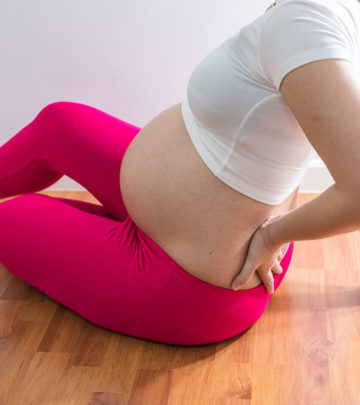What Is Resting Metabolic Rate And Why Is It Important?

Image: Shutterstock
Resting metabolic rate (RMR) is the amount of energy you burn when you are at complete rest. Your basic physiological functions like breathing, circulation, body temperature, brain function, organ and glandular functions, muscle repair, and other functions require energy in the form of calories. And RMR represents that number. But what is its function and how do you calculate it? Is a high RMR better or lower for weight loss? Read on to find all that information here. Swipe up!
Table Of Contents
- RMR Vs. BMR
- What Are Metabolism And Metabolic Rate?
- Why Is Resting Metabolic Rate Important?
- How To Calculate The Resting Metabolic Rate (RMR)
- 8 Factors That Affect Your RMR
- What Should Your Ideal RMR Be?
- How To Use Your RMR Data To Lose Weight
- How To Increase The Resting Metabolic Rate And Lose Weight
RMR Vs. BMR
RMR (Resting Metabolic Rate) is the number of calories burned when the body is at complete rest. RMR is calculated by lying on a bed for at least 15 mins to 1 hour and analyzing the oxygen usage and carbon dioxide release.
BMR (Basal Metabolic Rate) is a more accurate method of calculating the calories burned when the body is at rest. For this, you should not exercise for 24 hours, sleep for at least 8 hours, and get the test done in a 12-hour fasted state.
It’s clear that both RMR and BMR are important for losing weight and maintaining healthy body weight. In this article, to avoid confusion, I will talk only about RMR and why it is important. But before that, let’s understand what metabolic rate is.
What Are Metabolism And Metabolic Rate?
Metabolism is the chemical process through which your body converts food into usable energy. The metabolic rate is defined as the body’s energy expenditure per unit time.
The faster your metabolism, the greater your metabolic rate. And the fewer chances of you storing calories in the form of fat.
But if your metabolism or metabolic rate is slow, your body will take more time to convert food into usable energy. In this case, your chances of storing the unused food as fat are higher.
RMR (or Resting Metabolic Rate) is your metabolic rate when you are doing nothing or are at rest. So, your RMR will be lower than your metabolic rate when you are active. Makes sense? But the question is, if that’s so, why do we need RMR at all? Well, find out the answer in the next section.
Why Is Resting Metabolic Rate Important?
Resting metabolic rate is important to lose weight and maintain optimum body weight without hampering the basic body functions. Your RMR will give you an idea of how many calories you are burning at rest and how many calories you should be taking to lose fat (or gain muscle mass). To find out your RMR, you must know how to calculate it. Here’s a formula to calculate RMR.
How To Calculate The Resting Metabolic Rate (RMR)
To calculate RMR, you may use either a trusted online RMR calculator or the following methods:
1. Harris-Benedict Equation
- Women RMR (or BMR) = 447.593 + (9.247 x weight in Kg) + (3.098 x height in cm) – (4.330 x age in years)
- Men RMR (or BMR) = 88.362 + (13.397 x weight in Kg) + (4.799 x height in cm) – (5.677 x age in years)
2. Mifflin-St. Jeor Equation
- Women RMR (or BMR) = 9.99 x weight in Kg + (6.25 x height in cm) – (4.92 x age in years)
- Men RMR (or BMR) = 9.99 x weight in Kg + (6.25 x height in cm) – (5 x age in years)
3. Calculate In Metabolic Rate Testing Lab
You can also get your RMR calculated in specialized fitness clubs. You will be required to lie down and wear a mask for at least 15 minutes. Your oxygen usage and carbon dioxide release are measured, which determines the number of calories you have used during your resting phase.
Now, there are a number of factors that affect your RMR. Scroll down to find out what they are.
8 Factors That Affect Your RMR
- Age – With age, your RMR will decrease.
- Genetics – Your pre-coded genes may predict your RMR.
- Muscle – The less muscle you have, the lower your RMR will be.
- Meal Timing – Regular, small meals increase RMR.
- Crash Dieting – You lose muscle mass when you crash diet. So, your RMR decreases.
- Pregnancy – Increases RMR.
- Supplements – A few supplements may increase your RMR.
- Weather – If you live in a cold region, you will have increased RMR.
You must know what your ideal RMR is. Take a look at the following tables to know what your ideal RMR should be.
What Should Your Ideal RMR Be?
Here are two tables that determine the ideal RMRs for men and women of different heights.
RMR Chart For Women
| Height (feet) | RMR Range | Mean |
|---|---|---|
| 5’1” | 1120-1350 | 1240 |
| 5’2” | 1135-1370 | 1255 |
| 5’3” | 1155-1390 | 1275 |
| 5’4” | 1195-1430 | 1315 |
| 5’5” | 1235-1470 | 1355 |
| 5’6” | 1270-1500 | 1390 |
| 5’7” | 1310-1550 | 1430 |
| 5’8” | 1350-1585 | 1470 |
| 5’9” | 1370-1600 | 1490 |
| 5’10” | 1410-1650 | 1530 |
| 5’11” | 1450-1685 | 1570 |
RMR Chart For Men
| Height (feet) | RMR Range | Mean |
|---|---|---|
| 5’4” | 1200-1600 | 1400 |
| 5’5” | 1275-1685 | 1480 |
| 5’6” | 1340-1750 | 1550 |
| 5’7” | 1410-1870 | 1610 |
| 5’8” | 1480-1890 | 1680 |
| 5’9” | 1550-1960 | 1750 |
| 5’10” | 1615-2030 | 1815 |
| 5’11” | 1685-2095 | 1885 |
| 6’0” | 1750-2165 | 1950 |
| 6’1” | 1820-2235 | 2020 |
| 6’2” | 1890-2300 | 2100 |
| 6’3” | 1960-2370 | 2160 |
| 6’4” | 2030-2440 | 2230 |
What if your RMR is way too low and does not match the RMR range given in the chart? Here’s what you’ve got to do.
How To Use Your RMR Data To Lose Weight
To lose weight, your body must go into a negative energy balance (fewer calories in and more calories out). So, the more calories you use up, the better your body functions. You can achieve that by increasing your RMR. How can you do that? Find out in the next section.
How To Increase The Resting Metabolic Rate And Lose Weight
You may increase your RMR by doing the following:
- Exercising regularly. Do a mixed workout of 3 days of cardio and 2 days of strength training. When you lose a great chunk of fat, you may change this routine to 2 days of cardio and 3 days of strength training to build muscle. When you build muscle, your RMR will spike.
- Eating frequent, small meals. Eating every 2-3 hours will keep your metabolism active and increase RMR.
- Chewing food properly. Chewing will take up your energy and help burn calories. So, take your time and chew properly and slowly.
- Avoiding crash dieting. Crash dieting causes muscle loss. And you know that you need to have a certain percentage of muscle mass for your metabolism to be firing. When you lose muscle mass, your metabolism slows down even more. That’s why, post-crash dieting, dieters start storing food they consume as fat and quickly regain double the weight.
- Taking supplements. Taking protein supplements may help increase your RMR. Your muscles are made of protein. If you are not getting enough protein from your diet (0.8g – 1.5 g protein per kg body weight depending on your daily activity), you might take protein supplements and improve your muscle mass. This, in turn, would help increase your RMR.
NOTE: Talk to your doctor before taking any protein supplement.
So, you see, exercising and following a balanced diet and a healthy lifestyle are essential for increasing your resting metabolic rate. This, in turn, will help you lose weight.
To conclude, knowing your resting metabolic rate (RMR) will help you understand what your body needs. It will prompt you to take action and change your current unhealthy lifestyle. Changing your lifestyle is a time-consuming process, but it will help you in many ways. It will not only help you lose weight but also make you more productive and improve your mental health. So, get your RMR checked today and take a step toward a healthy, disease-free future.
Frequently Asked Questions
What is the average resting metabolic rate?
The average RMR differs from person to person depending on their sex and height. Check out the “What Should Your Ideal RMR Be?” section in this article.
What affects resting metabolic rate?
Your metabolic rate is affected by age, sex, daily activity, meal timing, muscle mass, pregnancy, genetics, and weather.
Does resting metabolic rate increase with exercise?
Yes, the resting metabolic rate increases with exercise. You must include strength training in your exercise routine.
Community Experiences
Join the conversation and become a part of our vibrant community! Share your stories, experiences, and insights to connect with like-minded individuals.














